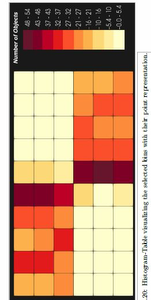Information
- Publication Type: Master Thesis
- Workgroup(s)/Project(s):
- Date: November 2020
- Date (Start): 12. January 2020
- Date (End): 24. November 2020
- TU Wien Library:
- Second Supervisor: Christoph Heinzl
- Diploma Examination: 24. November 2020
- Open Access: yes
- First Supervisor: Eduard Gröller

Abstract
In safety-critical areas such as aeronautics, but also in other sectors such as the leisure industry, the advancement of respective products is largely driven by the improvement of the materials used. In order to analyze the targeted properties of these new materials, data of the internal structures is generated, using imaging techniques such as X-ray computed tomography (XCT), which is then analyzed in detail using segmentation and quantification algorithms. For materials scientists, the exact design of the internal structures is crucial for the characterization of materials and a comparison of several material candidates based on their characteristics is therefore indispensable for the investigation of di˙erent manufacturing and optimization processes or property behavior.
Currently, material scientists are dependent on sequential comparisons when analyzing several material candidates. Distributions of the individual attributes across the material systems need to be compared, which is why this task is typically cognitively demanding, time consuming, and thus error-prone. This work aims to support domain experts in their daily tasks of analysing large ensembles of material data. For this purpose we developed a comparative visualization framework that provides a holistic picture of similarities and dissimilarities in the data by means of an overview visualization and three detailed visualization techniques. Using the dimension reduction method Multidimensional Scaling, the individual structures are summarized and rendered in a table-based visualization technique called Histogram-Table. Information, describing in which attributes the structures are most similar as well as their exact characteristics, is evaluated by statistical calculations, the results of which are visualized in a bar chart and box plot. Finally, the linear correlations between the individual characteristics can be explored in a correlation map. We present the usability of this visualization system by means of three concrete usage scenarios and verify its applicability by means of a qualitative study with 12 material experts. The knowledge gained from our work represents a significant step in the field of comparative material analysis of high-dimensional data and supports experts in making their work easier and more eÿcient.
Additional Files and Images
Additional images and videos
Additional files
Weblinks
BibTeX
@mastersthesis{Heim_2020,
title = "Visual Comparison of Multivariate Data Ensembles",
author = "Anja Heim",
year = "2020",
abstract = "In safety-critical areas such as aeronautics, but also in
other sectors such as the leisure industry, the advancement
of respective products is largely driven by the improvement
of the materials used. In order to analyze the targeted
properties of these new materials, data of the internal
structures is generated, using imaging techniques such as
X-ray computed tomography (XCT), which is then analyzed in
detail using segmentation and quantification algorithms. For
materials scientists, the exact design of the internal
structures is crucial for the characterization of materials
and a comparison of several material candidates based on
their characteristics is therefore indispensable for the
investigation of di˙erent manufacturing and optimization
processes or property behavior. Currently, material
scientists are dependent on sequential comparisons when
analyzing several material candidates. Distributions of the
individual attributes across the material systems need to be
compared, which is why this task is typically cognitively
demanding, time consuming, and thus error-prone. This work
aims to support domain experts in their daily tasks of
analysing large ensembles of material data. For this purpose
we developed a comparative visualization framework that
provides a holistic picture of similarities and
dissimilarities in the data by means of an overview
visualization and three detailed visualization techniques.
Using the dimension reduction method Multidimensional
Scaling, the individual structures are summarized and
rendered in a table-based visualization technique called
Histogram-Table. Information, describing in which attributes
the structures are most similar as well as their exact
characteristics, is evaluated by statistical calculations,
the results of which are visualized in a bar chart and box
plot. Finally, the linear correlations between the
individual characteristics can be explored in a correlation
map. We present the usability of this visualization system
by means of three concrete usage scenarios and verify its
applicability by means of a qualitative study with 12
material experts. The knowledge gained from our work
represents a significant step in the field of comparative
material analysis of high-dimensional data and supports
experts in making their work easier and more eÿcient.",
month = nov,
address = "Favoritenstrasse 9-11/E193-02, A-1040 Vienna, Austria",
school = "Research Unit of Computer Graphics, Institute of Visual
Computing and Human-Centered Technology, Faculty of
Informatics, TU Wien",
URL = "https://www.cg.tuwien.ac.at/research/publications/2020/Heim_2020/",
}

 Image
Image Master Thesis
Master Thesis Poster
Poster


